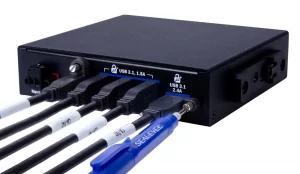Increasing Need for Locking, High-Retention USB Solutions
In recent years, RS-232 ports have largely been displaced from computers as USB ports emerge as the preferred serial interface for industrial environments. Data rate speed and durability are the two primary factors influencing this migration. With the introduction of USB 3.2 in 2017, data rates that are up to 100,000 faster than RS-232 have been achieved. Additionally, the small pins on traditional serial ports can be easily bent, minimizing their reliable operation in extreme environments where shock, vibration, and other physical disturbances are present. However, one of the primary features of USB can also be its downfall: the USB mechanical connector was intentionally designed to be quickly connected and disconnected. As a result, accidental cable disconnection is a common failure for industrial USB devices.
About SeaLATCH Locking USB Connectors
Sealevel’s patent-pending SeaLATCH® locking USB connectors feature a thumbscrew that provides a secure, metal-to-metal connection to avoid interrupted operations for critical communications. SeaLATCH locking USB ports are integrated into Sealevel:
- SuperSpeed USB 3.1 Hubs
- USB 2.0 Hubs
- SeaI/O USB Expansion and Data Acquisition Devices
- SeaDAC Lite USB Digital I/O Modules
- SeaLINK® USB Serial Adapters
- Embedded Computers
“We’re excited about the increasing applications that benefit from locking connectors. Originally, this was a driver primarily for our military and aerospace customers but now we are seeing a drone and UAV use increase across industries – and the inherent vibration makes a solution like SeaLATCH highly desirable,” aid Earle Foster, Sr VP of Sales for Sealevel.

